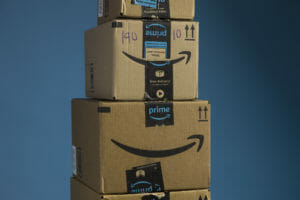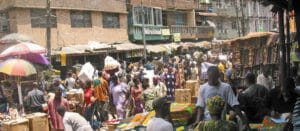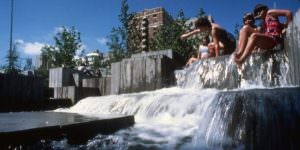Cities, Cars and Other Human-Made Things Weigh 30 Trillion Metric Tons
The first attempt to measure the volume of stuff created by humankind reveals that it is at least 100,000 times heavier than the global human population.
By Tim Radford / Climate News Network

Scientists have recorded a tally of 50 kilograms of human artifact for every square meter of the earth’s surface. (Yinan Chen via Flickr)
LONDON — Scientists have calculated the mass of that unnatural achievement called the “technosphere”, demonstrating the scale of human activity that drives climate change. The bleak conclusion is that cities, factories, cars, railways, cameras, computers, ballpoint pens, swords, machine guns and all other manmade things now weigh about 30 trillion tonnes.
The scientists also estimate that the number of “technofossil” species is greater than the number of living species on planet Earth.
Human impact
Those 30 million, million tonnes of accumulated excavation, ore and manufacture can be seen as the physical residue of the colossal exploitation of energy, much of it in the form of fossil fuels that is returned to the atmosphere as greenhouse gas carbon dioxide to trigger global warming and potentially catastrophic climate change.
The scientists, from 24 institutions in 11 countries, report in the journal The Anthropocene that they made estimates of the mass of the bricks, mortar, minerals and biological materials that humans had mined, excavated or in some way altered or reprocessed in the last 10,000 years.
They calculated the area of cities, rural housing, pasture, cropland, trawled seafloor, eroded soil, roads, plantations, reservoirs and railways. They included docks, quarries, mines, canals, levees, dams, sewage tunnels, metro systems, paved open spaces and all other marks made by humankind to tally a record of 50 kilos of human artefact for every square metre of the Earth’s surface.
Urban areas, for example, cover 3.7 million square kilometres, to an average thickness of two metres, with a mass of more than 11 trillion tonnes.
Rabbits burrow, termites make anthills, wasps make nests. All creatures alter their own environment to some extent. Humans have quadrupled their numbers in the last century and now represent the greatest vertebrate mass of any species on the planet, but this enormous bulk of construction outweighs its manufacturers at least 100,000-fold.
Jan Zalasiewicz, a palaeontologist at the University of Leicester in the UK, who led the study, says: “The technosphere is the brainchild of the US scientist Peter Haff — also one of the co-authors of this paper. It is all of the structures that humans have constructed to keep them alive, in very large numbers now, on the planet: houses, factories, farms, mines, roads, airports and shipping ports, computer systems, together with its discarded waste.”
“Humans and human organisations form part of it, too — although we are not always as much in control as we think we are, as the technosphere is a system, with its own dynamics and energy flows — and humans have to help keep it going to survive.”
The study adds emphasis to an argument that has kept geologists busy for more than a decade: that human change to the planet is now at such a scale that there is a case for declaring a new geological epoch, the Anthropocene.
It also backs up other research: that human artefacts are now embedded in geological strata, while human action is beginning to alter the biological cycles and atmospheric patterns in dangerous ways and has certainly begun to alter the climate cycle.
And the Leicester report builds on studies already published. In 2004, researchers confirmed once again that humans had become the greatest earth-moving force on the planet with a study in the US journal Geology that suggested that humankind was now shifting soil and rock 10 times faster than the wind and the rain. The scale of this exploitation continues to increase.
‘Technofossil’ species
This increase will be preserved, the Leicester study suggests, in the astonishing variety of manmade things — coins, computers, smartphones, pens, concrete fragments and plastic cups — now becoming embedded in sediments.
These “technofossil” species, they write, represent a diversity that “already exceeds known estimates of biological diversity as measured by richness, far exceeds recognised fossil diversity, and may exceed total biological diversity through Earth’s history”.
But Anthropocene change is very different from the kind of terrestrial alteration made by termites, bees, corals or rabbits, according to co-author of the report Mark Williams, a palaeobiologist of the University of Leicester.
“The technosphere can be said to have budded off the biosphere and arguably is now at least partly parasitic on it. At its current scale the technosphere is a major new phenomenon of this planet — and one that is evolving extraordinarily rapidly,” he says.
“Compared with the biosphere, though, it is remarkably poor at recycling its own materials, as our burgeoning landfill sites show. This might be a barrier to its further success — or halt it altogether.”
Tim Radford, a founding editor of Climate News Network, worked for The Guardian for 32 years, for most of that time as science editor. He has been covering climate change since 1988.
Your support is crucial...As we navigate an uncertain 2025, with a new administration questioning press freedoms, the risks are clear: our ability to report freely is under threat.
Your tax-deductible donation enables us to dig deeper, delivering fearless investigative reporting and analysis that exposes the reality beneath the headlines — without compromise.
Now is the time to take action. Stand with our courageous journalists. Donate today to protect a free press, uphold democracy and uncover the stories that need to be told.






You need to be a supporter to comment.
There are currently no responses to this article.
Be the first to respond.